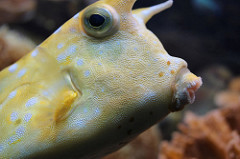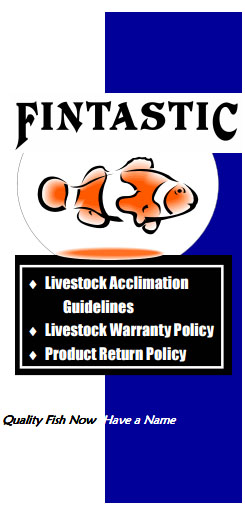Aquarium Maintenance Checklist
| Aquarium Maintenance Checklist: Daily |
| § Visual Inspection of Aquarium Equipment Spend a few minutes each day verifying that your pumps are working properly, that your heater and chiller are fully functional and that your other equipment—calcium reactor, protein skimmer, Ultraviolet Sterilizer, media reactors, Ozonizer—are operating as intended. Perhaps you’re already checking on your lights but it’s a good idea to check on all your hardware, like an auto top-off, once each day. I find the best time to perform the visual inspection of equipment is while I’m feeding my fish and corals.§ Visual Inspection of Aquarium Livestock Look closely at each of your fish for signs of disease (any salt grain looking spots, sores, missing scales, bleeding, etc.) and aggressive wounds (again missing scales caused from another inhabitant that may need to be removed). Scan each coral to see if it is healthy and that there are no “pests” present (red flatworms, red bugs, acro-eating flatworms and harmful Nudibranchs, for example). During feeding while your livestock is out/open is the best time to perform the visual inspection. § Monitor Aquarium Temperature |
|
|
|
| Aquarium Maintenance Checklist: Weekly | |
| § Water Tests Test important water parameters at least once each week. This includes but is not limited to salinity, calcium, alkalinity, nitrates, phosphates and magnesium. Master or multi-test kits are inexpensive and generally include tests for the parameters most important to keep an eye on.§ Water Change Not everyone is on the weekly water change schedule, but it’s a good rule of thumb to change your water each week or every other week. Use any high-quality siphon or ask our staff members which one they prefer while performing water changes in the store. For more effective crevice cleaning, use a turkey baster or narrow stream power head (like Cobalt’s Maxi Jet 1200) to blow out any trapped detritus that has accumulated in your rockwork. Then use your siphon to remove it from the tank during your water change. § Clean Protein Skimmer Collection Cup |
| § Clean/Scrub Algae from Tank Interior Algae grows quickly in a reef aquarium due to the high lighting requirements. Using a magnetic algae scraper once per week will keep your tank walls algae-free. Most magnetic algae scrapers can be kept inside your aquarium which is not only convenient but also means you never have to get your hands wet while cleaning. If you have a glass aquarium and are dealing with some really stubborn algae growth, try Magfloat’s scraper attachment.If you prefer getting your hands wet, there are certainly alternatives to magnetic algae scrapers. Hand-held algae pads are easy to work with. One of my personal favorites is the Python Algae Mitt. Kent Marine has a popular line of blade-style algae scrapers called Proscrapers that effectively cut through all different types of algae and are available in various sizes and styles. TIP: I use Marineland’s Hang-On Tank Magnum 250 Canister Filter to catch algae that has been scraped loose or a small diameter vinyl tube. The included micron cartridge catches algae so you can easily remove it from the tank. The cartridges are reusable and include instructions for cleaning. They are also great for catching the detritus blown off live rock. They can be used on tanks of all sizes to help maintain pristine water quality. Additionally, the Cobalt hang-on maintenance filter works exceptionally well or even us a small diameter vinyl tube to a sewer or bucket. § Wipe Down Tank Exterior
§ Check Auto Top-Off Reservoir Aquarium Maintenance Checklist: 1-2 Months |
| § Clean Pumps and Powerheads I have several pumps performing various jobs for my aquarium system. To keep things simple, I’ll clean a few pumps one month and then clean the remainder the following month. To remove coralline algae from aquarium pumps/powerheads I soak them in an Equipment Cleaner and use a brush kit to clean the impeller and housing. Don’t forget to clean the pumps being used with skimmers, chillers and reactors. Keeping your pumps and powerheads clean will make them last and perform like new.§ Change Carbon and/or Phosphate Media Carbon and phosphate media should be changed about once per month when using a very high quality media. Using a media reactor (like Two Little Fishies Phosban Reactor, Vertex media reactor, MRC media reactor) for carbon or phosphate media (GFO – Granulated Feric Oxide) not only makes changing out the media easier, it maximizes the potential of the media itself by preventing the water from bypassing it. |
|
| § Water Change Perhaps we’re not all weekly water changers. But the longest a reef aquarium should go without a water change is one month. I prefer a 10-15% water change every other week or a 25% water change monthly. This assumes very high quality filtration. Your test kits will let you know if this is adequate.§ Clean and Calibrate Probes (pH in particular) Use a soft-bristle toothbrush to clean probes. Gently brush the tip of the probe to get rid of anything that has built-up or accumulated on it. Soaking in white vinegar can also be acceptable. Recalibrate the probe afterward to ensure it is still providing accurate readings. Aquarium Maintenance Checklist: 6-12 Months |
|
| § Clean Return Pump The impeller on your return pump will undoubtedly accumulate some slime or calcium build-up during a 6-12 month stretch that will reduce its efficiency. Get that pump in like-new condition by taking it apart every 6-12 months and cleaning the gunk out. This will extend the life of the pump and enable it to push the maximum amount of water it was intended to. You can use vinegar to soak the parts, but sometimes you will need to use a commercial soaking solution to achieve “like new condition”.§ Replace Aquarium Light Bulbs Depending on the type of bulbs you are running over your reef, it might be time to replace your bulbs. If you are not sure how frequently to change your aquarium light bulbs, this is a very general guideline:
|
|
| § Replace RO or RO/DI Filter Media Most reverse osmosis equipment manufacturers recommend replacing the sediment, carbon and DI cartridges every 6 months depending on individual use. Keep a journal to log your replacement schedule and/or use a TDS meter to determine when it’s time to make a change to the DI and/or RO membrane. Your RO membrane will last about two years; with the addition of a flush valve it may last three or four.§ Replace Monitor Controller Probes Probes to monitor pH, ORP, Salinity, etc. generally last 12-18 months. If your probes become difficult to calibrate or go out of calibration quickly, it’s time to replace them. |


 Our Product Return Policy
Our Product Return Policy
